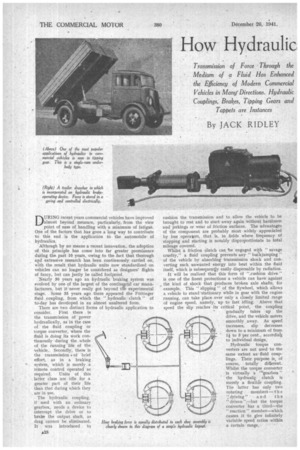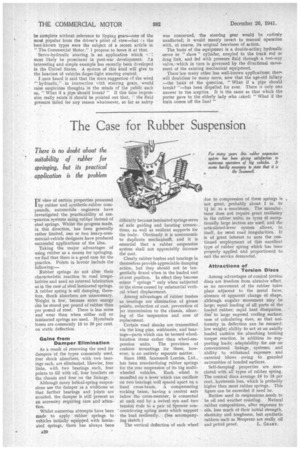How Hydraulic [aye Helped Designers of "Fieavies"
Page 20

Page 21

Page 22

If you've noticed an error in this article please click here to report it so we can fix it.
By JACK RIDLEY
DURING recent years commercial vehicles have improved almost beyond measure, particularly, from the view point of ease of handling with a minimum of fatigue. One of the factors that hasgone a long way to contribute to this end is the application to the automobile of hydraulics.
Although by no means a recent innovation, the adoption of this principle has come into far greater prominence during the past 10 years, owing to the fact that thorough and extensive research has been continuously carried on, with the result that hydraulic units now standardized on vehicles can no longer be considered as designers' flights of fancy, but can justly be called foolproof.
Nearly 30 years ago an hydraulic braking system was evolved by one of the largest of the continlotal car manti facturers, but it never really got beyond tile experimental stage. Some 35 years ago there appeared the FOttinger !laid coupling, from which the "hydraulic clutch" of to-day has developed in an almost unaltered form.
to The hydraulic coupling, if used with an ordinary gearbox, needs a device to interrupt the drive or to brake the output shaft, as drag cannot be eliminated. It was introduced to cushion the transmission and to allow the vehicle to be brought to rest and to start away again without harshness and jerkings or wear of friction surfaces. The advantages of the component are probably most widely appreciated by bus 'operators, that is, in fields where frequency of stopping and starting is notably disproportionate to total mileage covered. Whilst a friction clutchcan 'be 'engaged with "savage cruelty," a fluid coupling prevents any ." buCkjumping ." of the vehicle by absorbing transmission shock and converting such unwanted energy into heat within the fluid itself, which is subsequenVy easily dispersable by radiation.
It will be realized that this form of "_cushion drive" is one of the finest protections a vehicle can have against . the kind of shock that produces broken axle shafts, for example. This " slipping " of the flywheel, which allows a vehicle to stand'stationary while in gear with the engine running, can take place over only a closely limited range of engine speed, namely, up to fast idling. Above that speed the slip reaches its critical point, the coupling gradually takes • up the drive, and the vehicle moves smoothly away. As speed
' increases, slip decreases down to a minimum of from lf to 3 per cent., according to individual design.
Hydraulic torque converters are net used to the same extent as fluid couplings. Their purpose is of course, totally different. Whilst the torque converter is virtually a "gearbox" the hydraulicclutch is merely a flexible coupling. The latter has only two rotating member t —t he
driving " and the "driven "but the torque converter has a third—the " reaction " member—which causes it -to give infinitely variable speed ratios within a certain range.
The confined use of torque converters on road vehicles is probably due to their rather complicated nature, and even then the ordinary gearbox is not entirely dispensed with, as a mechanical reverse has to be incorporated, whilst usually an auxiliary extra-low gear is provided also for emergencies not allowed for by the somewhat curtailed range of torque conversion available with units of this kind, So much for transmission systems. The other hydraulic application referred to, represented by the remote control, exists in a far greater number of cases, in fact there is almost no limit to the uses to which hydraulic remote controls could be put.
Most prominent of these systems is hydraulic braking. the Lockheed being too well known to warrant further description at this juncture. Among advantages may be named the fact that hydraulic operation gives equal braking on all drum's, because no appreciable retarding action can take place until all the shoes are in contact with the braking surfaces of their respective drums, after which, the hydraulic pressure being equal in all directions, perfectly balanced braking is afforded.
Different combinations of braking can, of course, be obtained, such as greater retarding effort on the front brakes than on the rear, or vice versa, or the isolating of the front brake system from the rear. These conditions are arranged by using, respectively, larger diameter brakethoe cylinders for one pair of wheels than for the other pair, and by employing a tandem master cylinder, one element of which controls the front brakes, and the other those acting on the back wheels.
Heaviness of operation is cut down to a minimum owing to the absence of steel rads, rod supports, plain bearings, bell cranks and knuckle joints, etc., thereby leaving no parts to rust up and suffer the ravages of rain, grit and mud. Furthermore, the fluid throughout the system is a permanent lubricant to all working parts.
A step farther with hydraulic braking is to combine it with servo gear. Power assistance to braking has been practised for many years by various methods, the most prominent being, perhaps, the vacuum-servo system. Power for brake application can also be obtained in a totally different manner from the usually understood cornpressed-air or vacuum system. The Lockheed-Gates " booster " is an example.
Energy for operating this unit is obtained by regeneration, that is, by the utilizing of the kinetic energy contained in
the -vehicle itself by reason of its momentum. The p•opeller shaft of the vehicle drives a small multiple-plate clutch which is engaged only when the driver depresses the
brake pedal. As a result, the brakes are applied to a degree proportional-to the effort exerted by the driver; in other words the servo action is "progressive." Another interesting hydraulic application is found in a unit for the operation of light-trailer brakes. Self-con tained, the device is incorporated in the drawbar It obtains its energy for braking from a large spring which is compressed by the tractive effort of the towing vehicle. It should be pointed out, however, that this spring does not bob about like a dancing doll due to the alternations of "pull " and "over-run " between the two The action of the trailer over-running the master vehicle does not cause braking during ordinary running periods, but does contribute to the braking effort only when the driver applies the brakes, and then always tc‘ a degree in proportion to. the loading of the trailer.
Once the spring is compressed it can be released to operate the brakes only by an electric contact on the footbrake pedal, which operates a fluid valve,' which in turn holds -the compressed spring in check ready for braking when wanted.
Yet another application of hydraulics—this time inside the engine—is the hydraulic tappet. With all mechanically operated valves it is a practical impossibility to achieve the ideal, that is, the state where the valve is positively resting on its seat, yet leaves no clearance between tappet or overhead rocker and valve stem. If tappets could be adjusted so that both these theoretical conditions were exactly fulfilled, all the adjustment would be lost when any temperature change took place. Hence the mechanic's sixth-sense injunction, "always leave four-thou. (or so)' tappet clearance."
Not so with the hydraulic tappet. This, in simple language, is a solid column of oil interposed between the valve stem and the camshaft. This column is maintained by the engine oil pump, there being sufficient pressure to take up all clearances and backlash, but not enough to open the valve without the lifting action of the cam, otherwise, of course, the valve would be held permanently open. It will be seen that temperature changes will not cause any difficulties at all—whatever differences of space the valve decides to leave between itself and the cam, owing to heat variation, the oil will fill this space 100 per cent., but no more, and so, when the cam commences to lilt, it will have a solid mass to push against; instead of having to take up noiseand wear-producing clearances and
backlashes. • This review of commercial-vehicle hydraulics would not be complete without reference to tipping gears—one of the most popular from the driver's point of view—but ri the best-known types were the subject of a recent article in " The Commercial Motor," I propose to leave it at that.
Servo-hydraulic steering is an application Which e--1 most likely be prominent in post-war development. !-n interesting and simple example has recently been developed in the United States. A system of this kind will give to the heaviest of vehicles finger-light steering control.
I once heard it said that the mere suggestion rf the word " hydraulic," -10 connection v:ith steering gears, would raise suspicious thoughts in the minds of the public such as, " What if a pipe should break? " If this false impres sion really exists it should be pointed out that, the fluid pressure failed for any reason whatsoever, so far as safety was concerned, the steering gear would be entirely unaffected; it would merely revert to manual operation with, of course, its original heaviness of action.
The basis of the equipment is a double-actin; hydraulic servo or " slave " cylinder, coupled to the track rod or drag link, and fed with pressure fluid through a two-way. valve, -which in turn is governed by the directional movement of the existing mechanical equipment.
There-are nianY other less well-known applications; there will doubtless he many more, now that the age-old fallacy —the basis of the question, " What if a pipe should break? "—has been dispelled for ever. -There is only one answer to the sceptics. It is the same as that which the porter gave to the elderly lady who asked: " What if the train comes off the line? "




















































